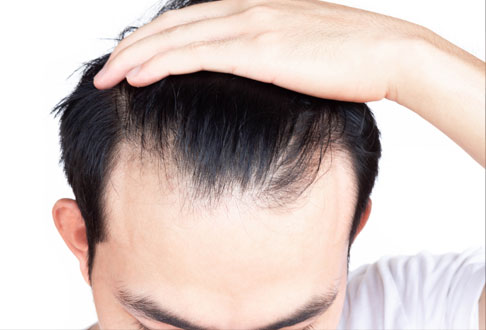
En qué consiste el trasplante capilar
La clínica capilar que se centra en las personas
Muchas son las cuestiones que surgen cuando se habla de calvicie, especialmente, masculina. Esto es lógico, ya que la sociedad española sufre en gran medida de esta tan famosa enfermedad. El trasplante capilar se impone como la mejor solución para todo aquel que tiene este problema tan habitual. En este artículo queremos explicarte a fondo en qué consiste el trasplante capilar y por qué es la mejor opción para ponerle fin a la alopecia.
Aunque con diferente intensidad, la calvicie tiene una mayor incidencia en individuos de hasta 50 años de edad, ya que la población afectada tiende a aumentar con el paso de los años, por lo que se extiende a todos los grupos etarios, afectando de diversas formas a nuestra población.
La pérdida de cabello
La pérdida de cabello influye en la pérdida de autoestima, ya que la persona afectada comienza a sentirse menos atractiva y más insegura, incluso evitando las relaciones sociales o profesionales más elementales. Por lo tanto, la calvicie tiene consecuencias importantes sobre la vida y el bienestar de los afectados, potenciando el aislamiento y la depresión. Además, la calvicie es actualmente uno de los problemas más comunes que afectan a la población más joven. Esta patología tiene implicaciones tan profundas que va más allá de la mera cuestión estética y debe tratarse en un entorno clínico, con un seguimiento adecuado.
Ante problemas de alopecia lo mejor es contar con la valoración de un profesional médico, el cual nos dará un diagnóstico que dictaminará el tratamiento a seguir. Puede variar entre los productos de aplicación tópica, medicamentos, tratamientos capilares y/o trasplante capilar.
Pero sin duda, el tratamiento más efectivo, que constituye la cura definitiva para la calvicie es el trasplante capilar. Será de vital importancia que sea un especialista quien realice la evaluación capilar, verificando el grado de calvicie, la calidad del folículo y el cuero cabelludo.
Por supuesto, la herencia genética juega un papel clave en la caída del cabello. Este proceso puede verse influenciado por factores externos que lo agravan (estrés, alimentos, productos o técnicas de peluquería agresivas). Cuando se instala el problema, la solución más efectiva es el trasplante capilar, que consiste en la extracción de unidades foliculares sanas de la zona donante y la posterior implantación en la zona afectada.

¿Qué es el trasplante capilar?
El trasplante capilar consiste en llevar unas unidades foliculares de la zona donante (normalmente la nuca) a las partes donde ya no hay pelo. De esta forma volverá a crecer y sin riesgo de rechazo para el paciente. Hoy, gracias a los avances tecnológicos en el área del trasplante de capilar es posible recuperar la densidad y la línea capilar pérdida.
El trasplante de cabello debe ser realizado por un equipo médico que utilice tecnología y equipos motorizados de alta precisión, para poder restaurar la densidad del cabello en aquellas áreas donde la falta de cabello sea irreversible.
La intervención del trasplante es indolora debido a que se administra anestesia local que elimina la sensibilidad en el área de extracción e implantación. Uno de los procedimientos más utilizados y actuales es la técnica FUE (Follicular Unit Extraction), que proporciona mejores resultados, ya que las unidades foliculares se extraen e implantan una por una, garantizando una apariencia final natural.
Sin embargo, el resultado final del trasplante depende esencialmente de la calidad del material folicular, el equipo utilizado y el grado de especialización de los profesionales que lo realizan.
El trasplante capilar es un procedimiento indoloro, sencillo y seguro, con la garantía de que los resultados serán efectivos y naturales. La intervención es indolora debido a que como dijimos anteriormente, se administra anestesia local que elimina la sensibilidad en el área de extracción e implantación.
Esto permite que el paciente esté despierto durante el tratamiento y siga todo el proceso: puede ver la televisión, hablar, usar el móvil, etc.
Siempre y cuando la intervención sea realizada por profesionales y con el equipo adecuado, nunca dejará cicatrices. Los resultados serán de calidad y la ejecución se logrará de forma rápida.

Seguridad
El trasplante capilar es un procedimiento altamente fiable, ya que se obtienen las unidades foliculares de las áreas donantes del propio cuero cabelludo del paciente, por lo que el riesgo de rechazo es inexistente. Si además se realiza con un equipo especializado y la más alta tecnología no debería existir ningún problema.
Detectar si la pérdida de pelo es normal
La pérdida de cabello normal ronda los 100 cabellos al día, y ese número puede aumentar a 150 en algunos casos. Un número mayor resultaría preocupante y puede significar que la densidad capilar esté en riesgo. Una forma de comprobar si la caída está siendo excesiva sería, por ejemplo, si la cantidad de cabello en el desagüe de la bañera o en el piso, después de peinarse, comienza a elevarse de manera extraña. Si esto es así, es muy probable que tengamos una caída excesiva, por lo que sería recomendable acudir a una consulta de evaluación capilar.
Causas
Está comprobado que pasar por situaciones de gran estrés emocional pueden conllevar a la pérdida de pelo, siendo 11 veces más propenso a ello en comparación a alguien que no sufra de estrés. Además, puede sucederle tanto a hombres como a mujeres indistintamente.
El daño que producen las gomas del pelo, especialmente, cuando son de un material muy duro y agresivo. Por eso es preferible utilizar los de silicona o los recubiertos de tejido. De lo contrario, pueden dañar el cabello, haciéndolo más susceptible a caerse, por el tirón que generan. Es la llamada pérdida de cabello por tracción, que ocurre con el uso prolongado de gomas o cepillados del cabello demasiado agresivos.
La genética es otro factor que puede influir en la caída de nuestro pelo. Aunque frente a este problema no existen remedios naturales.
Cuando se ven resultados
Al final de los seis meses, los resultados comienzan a aparecer y se hacen más evidentes cada mes. Pero en muchos casos, especialmente si se realizan tratamientos complementarios, ya es posible obtener resultados visibles después de tres o cuatro meses.
Cómo elegir la clínica para hacer un trasplante de cabello
El trasplante de cabello es un procedimiento meticuloso y muy exigente, la extracción y la implantación requieren de un equipo clínico con un alto conocimiento técnico y una experiencia probada por los numerosos trasplantes realizados.
Los resultados obtenidos de este procedimiento, pueden estar condicionados, si se tienen en cuenta aspectos como el coste asociado, descuidando el grado de especialización y la tecnología utilizada.
Insparya utiliza la tecnología y un equipo motorizado de alta precisión, llamado Insparya Dual Extraction Device, que permite obtener los mejores resultados posibles, ya que logra trasplantar un mayor número de unidades foliculares en la mitad de tiempo.


